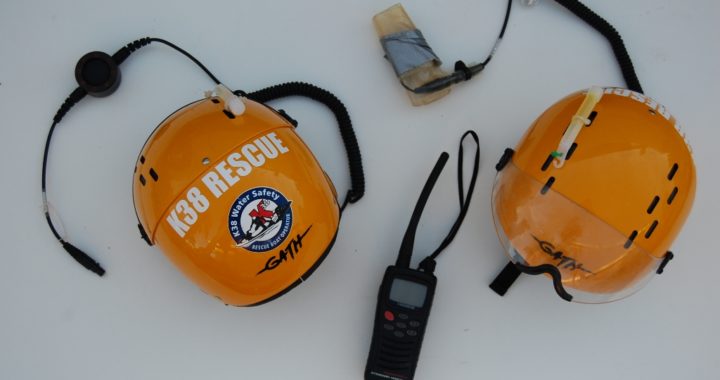MARINE VHF RADIO
Let’s take a very quick basic overview of the use and function of a Marine VHF radio analog technology. Keep in mind there is a lot more to know FOR VHF Radio use, so use this guide as a precursor for further educational benefits by conducting your own research. VHF band is by law intended for use by mariners.
TERMINOLOGY-Marine VHF radio refers to the radio frequency range between 156 and 174 MHz VHF signifies the ‘Very High Frequency’ of that range. So that leads to what is MHz? Megahertz is used to express microprocessor clock speed. The unit is occasionally used in measurements of bandwidth for high speed digital data, analog and digital video signals and spread spectrum signals.
International Distress, Safety and Calling. Ships required to carry radio, USCG, and most coast stations maintain a listening watch on this channel.
CHANNEL 16- Marine VHF radio Channel 16 (156.800 MHz) Boater Calling Channel (VHF Channel 9)
The Federal Communications Commission established VHF-FM channel 9 as a supplementary calling channel for noncommercial vessels (recreational boaters) at the request of the Coast Guard. A ship or shore unit wishing to call a boater would do so on channel 9, and anyone (boaters included) wishing to call a commercial ship or shore activity would continue to do so on channel 16. Recreational boaters would continue to call the Coast Guard and any commercial facility on channel 16.
The purpose of the FCC regulation was to relieve congestion on VHF channel 16, the distress, safety and calling frequency. FCC regulations require boaters having VHF radios to maintain a watch on either VHF channel 9 or channel 16, whenever the radio is turned on and not communicating with another station.
Since the Coast Guard generally does not have the capability of announcing an urgent marine information broadcast or weather warning on channel 9, use of channel 9 is optional. We recommend boaters normally keep tuned to and use channel 16 in those waters unless otherwise notified by the Coast Guard. Channel 16 is monitored by the United States Coast Guard (USCG) and they will issue weather, hazards and restriction placed on navigation alerts when they are needed in your area of operation (AO). There are 50 different channels available with select defined roles by the FCC. Once contact is made on Channel 16 the USCG may redirect you to another channel.
Channel 16 should be monitored when you are underway in case a distress signal and request for emergency support is issued you can respond. Keep this channel open for those who truly are in need of lifesaving connectivity.
Procedure for Calling A Ship by Radio
You may use channel 16 to call a ship or shore station, but if you do so, you must, must be brief! We recommend this same procedure be used over channel 9, if channel 9 is used as a calling channel.
For example:
Blue Duck: "Mary Jane, this is Blue Duck" (the name of the vessel or MMSI being called may be said 2 or 3 times if conditions warrant)
Mary Jane: "Blue Duck, this is Mary Jane. Reply 68" (or some other proper working channel)
Blue Duck: "68" or "Roger"
MAYDAY Radio Checks and other Hoaxes
A growing number of boaters unsuccessful in getting a radio check on VHF channel 16 are calling MAYDAY to get a response. Every hoax, including MAYDAY radio checks, is subject to prosecution as a Class D felony under Title 14, Section 85 of the U.S. Code, liable for a $5000 fine plus all costs the Coast Guard incurs as a result of the individual's action. Since hoaxes can lead to loss of life, the Coast Guard and Federal Communications Commission will work closely together, using when necessary FCC equipment capable of identifying the electronic signature of the offending radio. We ask your cooperation in helping us and the FCC remove hoaxes from the VHF radiotelephone distress, safety and calling channel 16.
Radio Checks
Radio checks with the Coast Guard Communications Stations on DSC and HF radiotelephone are allowed.
ETIQUETTE - Do not use foul language, do not allow children to handle your Marine VHF radio but do teach them how to use it properly for an emergency distress call, it is not a toy, and is monitored for transmissions that are forbidden. Keep Channel 16 open for true emergencies. Know the channels and their complimentary functions.
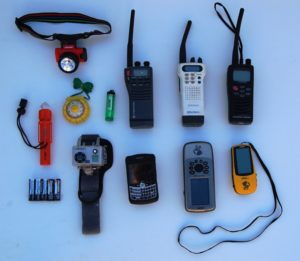
But most importantly, know your radio! You may want to place in a waterproof bag, and not all of them float. So we operate with them affixed to the front of our lifejacket, but not near our chest, off towards our shoulders. Marine VHF is not for shore use only for on-water, if used on land you are in violation of the law unless you have a special permit.
Don’t hog a channel, be mindful others may need to use it, it’s not a social device for communication but is intended to support safety at sea and navigational needs.
BATTERY-They have a self-contained antenna and battery pack. Normal range of battery life is approximately 8 hours, but it depends, some claim 20 hours of use, but for me, it’s dependent on location, weather and use of the radio. Batteries can fail due to corrosion of it the case is cracked of the cover not secure. Also make sure you use the proper charger and follow the charging instructions.
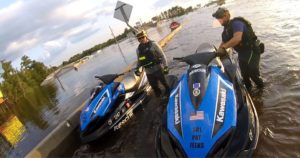
GPS
VISUALS-Being able to see the display helps to know which channel you are on. You can lock the channel in as well, we use iCom radios. Dot Matrix Display is helpful when choosing the menu functions, over a standard 7 segment LCD display. Dot Matrix pixilation count is rated for its screen resolution. Some are backlit brighter than others and the buttons as well.
GLOBAL-Some of the radios have a built in GPS that can send to the USCG your exact position in case of emergency. This provides you your Latitude and Longitude position. You can used stored waypoints with this feature for navigation. Some radios have Digital Selective Calling (DSC), it’s similar to using a device like Spot Locators as an emergency beacon. You just have to push down on a button usually lit as a red or orange emergency distress and it will send an automated digital distress message to the USCG and others vessels with radios in the vicinity. Channel 70 is Note that channel 70 is now authorized only for Digital Selective Calling, an emergency automated distress system mandated by international treaty; channel 70 may no longer be used for voice communication
This feature is great because you can store your emergency contacts. Some radios have other accessories such as different battery types or headsets. You can use your radio to hail Towing companies such as Vessel Assist, which is more reliable than using a cell phone due to dropped calls and on-water range, waterproofing and battery life.
K38 recommends you have a separate GPS tracking device. In case one fails you have a backup.
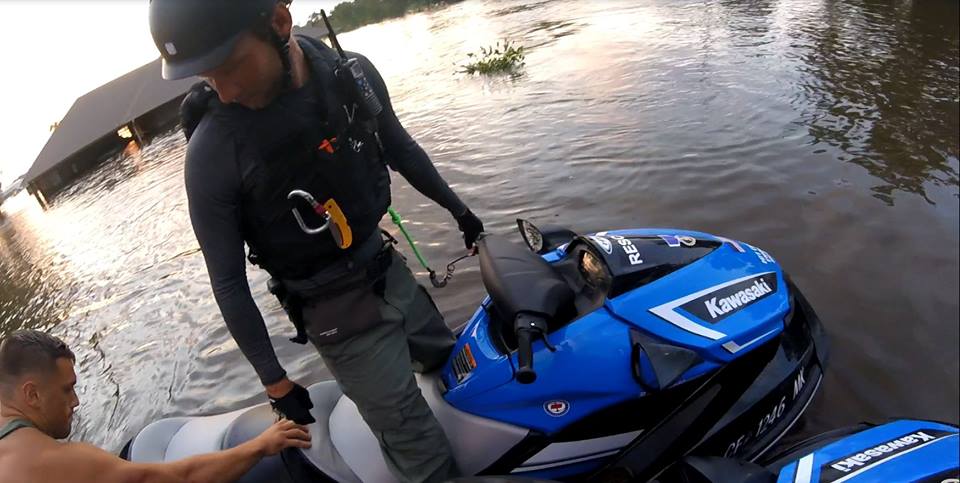
RWC VHF Radio
CARE
WATTAGE-There are limitations of range due to a transmit power of six watts. This is why you see some RWC operators in calmer waterways adding a larger external antenna to transmit from a high location. For our Rescue Water Craft use you can average a five watt transmit power to work at three to eight miles of range with variables. Switching to some models using higher watt output you may drain your battery quicker, so be careful on your settings.
Recreational Marine VHF radios for recreational boaters are limited to output of 25 watts so transmitters cannot be boosted and operate on a line of sight between stations, the higher the atenna the better the result. However our handhelds are limited.
BATTERY LIFE-Radio manufactures have a generic recommendation for battery life. 90% standby, 5% to receive and 5% to transmit at high power. Read the owner’s manual and you can have great tutorials on your specific brand model.
By having your radio with you on your person you can communicate when away from your Rescue Water Craft, which is a great safety feature for yourself as the Operator or Crew. Even better if the vessel capsizes and you are separated from the RWC you have a safety threshold to hail for assistance.
CAREFUL-Do not drop your radio! This is how irreversible damage occurs and can render the radio dead. Also any strikes to helm while underway can damage the lens or the housing and destroy your radio, so use due care! Never store your radio inside the glove box or any other compartment without completely protecting your radio from strike damage and breakage!
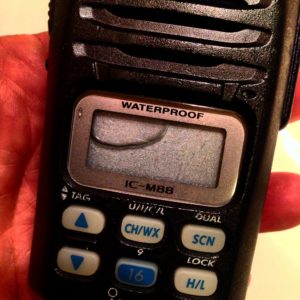
Make sure you use silicone grease to maintain an anti-corrosion base your battery housing for water or condensation inside the housing, mainly near the battery cover opening and the buttons and the antenna base. Apply silicone weekly to the battery terminals. Make sure the radio is dry before placing in charger.
Do not bend the antenna! If the rubber is cracked, replaced the antenna immediately.
Rinse with fresh water! What I like to do is to evacuate the water from the microphone and button areas to try to reduce the signature of corrosion. Conduct a final post inspection by opening up the battery case and look for condensation or water invasion, cracks in the case and be sure to use silicone grease to maintain anti-corrosion practices.
CHECK! If you want to hail a second Rescue Water Craft or vessel here is some advice:
1. Before you splash your RWC, make sure your radio is fully charged.
2. Power your Radio ‘on’.
3. Set your volume and squelch buttons.
4. Conduct a Radio Check on Channel 9 (noncommercial and non-emergency channel)
5. Make sure you are both operating on the same radio channel, Ch. 1078 is good for some areas if there is not a lot of traffic, but then switch back to 16 when underway to listen for emergencies
6. You can also monitor your local weather broadcasts on your VHF radio
7. Push down the mic key for clearance to talk, it’s usually located on the side of the radio, then send your message and depress the key button.
8. Hail the second RWC pressing the mic key and holding it by stating the vessel name twice, followed by your vessels name: “K38 one, K38 one, this is K38 two on Channel 1078, over” release the key.
9. Once contact is made, and our conversation is completed “K38 two returning to standby Channel 16 or K38 two out”. Do not say ‘over out’.
10. Channel 9 is designated for the boat calling channel (156.450 MHz)

Don't leave shore without your VHF Radio
EMERGENCY
1. Securite-Securite-Securite: Warns crew or others about important safety information. Also used to issue warnings and meteorological updates. Such as towing someone with restricted maneuverability and you want others to avoid you.
2. Pan-Pan-Pan: Urgent situation but not at imminent risk. You are in moderate risk, and a hazard to navigation
3. Mayday-Mayday-Mayday: SOS distress signal. Sets Search and Rescue (SAR) in motion. Life threatening situation. You are going down, you have lost a man overboard or you are heading to the beach or rocks, imminent danger.
During emergencies we can rely on our volunteer Ham radio operators. Ham radio operators using their frequency will state ‘Break-Break-Break’ as the equivalent to a Mayday call, never use the term ‘Break’ unless imminent threat to property or life is present.
Global Maritime Distress & Safety System
VHF maritime channel 70 (156.525 MHz) is authorized exclusively for distress, safety and calling purposes using digital selective calling (DSC) techniques. No other uses are permitted.
Channel 70 is used to send distress alerts, safety announcements and for calling purposes under the Global Maritime Distress and Safety System (GMDSS). Many vessels are now equipped with DSC capability and are using channel 70 for this purpose. It is essential that this channel be protected.
Storm Warnings?
The Coast Guard announces storm warnings and other urgent marine information broadcasts on VHF channel 16 before making the broadcasts on VHF channel 22A and 2670 kHz respectively. Storm warnings and forecasts are also made by NOAA Weather Radio.
REFERENCE
Channel 16
International Distress, Safety and Calling. Ships required to carry radio, USCG, and most coast stations maintain a listening watch on this channel.
Channel 70
Digital Selective Calling (voice communications not allowed)
Channel 1078
Non-Commercial. VDSMS (USA Great Lakes commercial channels 1079, 1080)
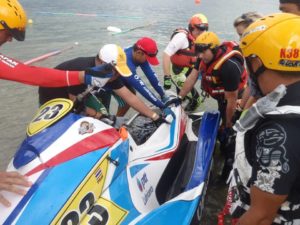
USCG INFORMATION: Frequencies are in MHz. Modulation is 16KF3E or 16KG3E.
Note that the four digit channel number beginning with the digits "10" indicates simplex use of the ship station transmit side of what had been an international duplex channel. These new channel numbers, now recognized internationally, were previously designated in the US by the two digit channel number ending with the letter "A".
That is, the international channel 1005 has been designated in the US by channel 05A, and the US Coast Guard channel 1022 has been designated in the US as channel 22A. Four digit channels beginning with "20", sometimes shown by the two-digit channel number ending with the letter "B", indicates simplex use of the coast station transmit side of what normally was an international duplex channel. The U.S. does not currently use "B" or "20NN" channels in the VHF maritime band. Some VHF transceivers are equipped with an "International - U.S." switch to avoid conflicting use of these channels. See ITU Radio Regulation Appendix 18 and ITU-R M.1084-5 Annex 4.
These new channel numbers should eventually begin to be displayed on new models of VHF marine radios.
Boaters should normally use channels listed as Non-Commercial. Channel 16 is used for calling other stations or for distress alerting. Channel 13 should be used to contact a ship when there is danger of collision. All ships of length 20m or greater are required to guard VHF channel 13, in addition to VHF channel 16, when operating within U.S. territorial waters. Users may be fined by the FCC for improper use of these channels.
_______________________________
Published: August 28, 2018
Updated: February 11, 2019 (special thanks to Rene Haar for a suggested correction)
Have any questions? Join the Rescue Water Craft Association
and discover what your community is doing to modernize standards, safety and reduce liability!
Join the Rescue Water Craft Association
Content Creator: Shawn Alladio cares most about her community and the culture surrounding the safety of event service providers and Rescue Water Craft operators, working hard and dedicated towards protecting their reputation, distributing safety information and continuing to train these amazing individuals to the highest standards of care.
Use at your own risk. Please take a qualified Rescue Water Craft training course and maintain proper records and respect all the PWC, RWC, PPE, and gear OEM manufacturer warning labels and cautions.
